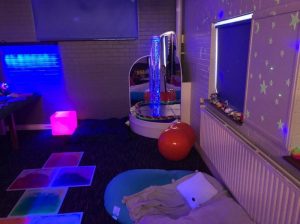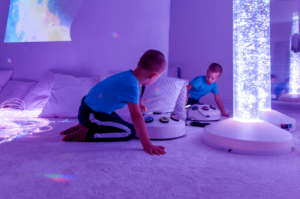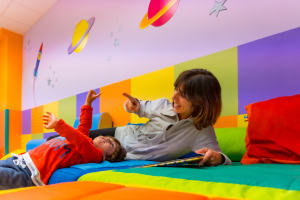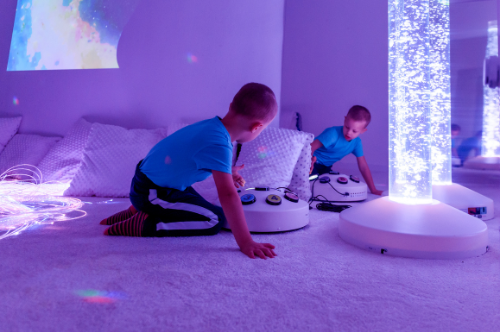
Exploring the Educational Advantages of Sensory Play
Sensory play is a cornerstone of childhood development, with creativity being a standout beneficiary. At Creative Play, we champion nurturing creativity through sensory engagement. While

Sensory play is a cornerstone of childhood development, with creativity being a standout beneficiary. At Creative Play, we champion nurturing creativity through sensory engagement. While

How can sensory rooms improve mental and physical health outcomes for neurodivergent patients?

Sensory Rooms can offer a lot to children and adults alike, but what are they?

Sensory Rooms are increasingly being adopted in family homes, schools, and libraries, here’s how you and your child can benefit from a well-designed room

How Sensory Rooms can benefit anyone, including adults and people who are not neurodivergent

Are you a parent, caregiver, or educator that wants to create a sensory stimulation environment to use in your home or workplace? Perhaps you’ve witnessed the impact it has on individuals with Autism or SPD and want to design a multimodal space but aren’t sure where to start? If this rings true for you, have a look at our guide to learn how to create an effective sensory area that will benefit everyone.
In the 1970s, two therapists developed the ‘Snoezelen’, a sensory stimulation environment designed with the purpose of helping their patients engage in play and activate their senses. In present times, the ‘Snoezelen’ has been renamed the “sensory room”. These spaces are popular treatment options to promote self-regulation and independence for individuals with Autism or SPD.
Sensory rooms are a successful therapeutic practice in over 400 countries. Not surprisingly, there is increasing interest among parents and caregivers who are pleased with their children’s positive changes. Parents and caregivers familiar with sensory processing disorders understand the importance of these spaces. To understand why these spaces are essential, we must examine two types of sensory issues.
The benefits of sensory stimulation have prompted parents and caregivers to establish a sensory stimulation environment in their homes. The same can be said for educators and businesses that want to provide a comfortable space where everyone, regardless of their sensory difficulties, may participate in everyday tasks.
Visualise a place that provides a respite away from crowds, noise disturbances, and harsh lights. This room would have light projectors casting a comforting glow, plush bean bag chairs to settle into, serene music, and interactive equipment to engage the senses. This is a common design plan for a sensory room. If you’re interested in establishing your own multimodal space but want to learn more about how it works and how to make a space that’s affordable, continue reading.
The beauty of these innovative spaces is that they are easily adaptable to any budget and scale. Multisensory areas only require that they be designed to meet every sensory need. This can be done with reasonably priced items and select pieces of equipment.
Multisensory settings are becoming more popular in homes and establishments across Ireland due to the numerous benefits they provide to people with Autism and SPD. Starting your sensory room design might seem daunting, but it doesn’t have to be. We’ve broken down the essentials of your design journey into a few simple phases. Start with these steps if you want to create a sensory area for your home or business.
In Ireland, multisensory rooms are gaining popularity, and more people are advocating for inclusive spaces in public places and specialised areas in the home. Parents, educators, and caregivers are rising to the occasion and developing strategies that cater to every sensory requirement. If you’ve got your basics down for your dream sensory room but need some inspiration on the finishing touches, take a look at our recommendations below.
Sensory stimulation environments are adaptable, diverse, and can be customised to any budget or need. If you happen to be over budget, don’t fret! A multisensory room equipment expert can appraise what is essential for your build. There are also a variety of funding opportunities available to help your project succeed. If you’re in need of more funds to develop a sensory stimulation area in your home or establishment, check out these options.
Designing a sensory stimulation environment is as simple as taking all the senses into consideration and creating a space that is soothing for self-regulation. If you’re interested in installing this area in your home, it can be personalised with sensory toys and equipment your child enjoys. If you’re a caregiver or educator that wants to propose this space in your workplace, make sure you design an environment that can meet both calming and interactive sensory requirements. With your design goals in mind, Total Sensory Solutions specialists can install a sensory room that fits all your requirements.
With over 25 years of expertise in the industry, we are a leading sensory space design enterprise. We make it our objective as a leading source of sensory toys and equipment in Ireland to design and build facilities that match your child’s sensory necessities.
If you want to create a sensory space in your home or workplace but require guidance in completing your design — call us on 01 8414933 or send us a message.
Total Sensory Solutions Ltd,
Gormanston,
Co. Meath,
K32 PA02.
| Cookie | Duration | Description |
|---|---|---|
| cookielawinfo-checkbox-analytics | 11 months | This cookie is set by GDPR Cookie Consent plugin. The cookie is used to store the user consent for the cookies in the category "Analytics". |
| cookielawinfo-checkbox-functional | 11 months | The cookie is set by GDPR cookie consent to record the user consent for the cookies in the category "Functional". |
| cookielawinfo-checkbox-necessary | 11 months | This cookie is set by GDPR Cookie Consent plugin. The cookies is used to store the user consent for the cookies in the category "Necessary". |
| cookielawinfo-checkbox-others | 11 months | This cookie is set by GDPR Cookie Consent plugin. The cookie is used to store the user consent for the cookies in the category "Other. |
| cookielawinfo-checkbox-performance | 11 months | This cookie is set by GDPR Cookie Consent plugin. The cookie is used to store the user consent for the cookies in the category "Performance". |
| viewed_cookie_policy | 11 months | The cookie is set by the GDPR Cookie Consent plugin and is used to store whether or not user has consented to the use of cookies. It does not store any personal data. |